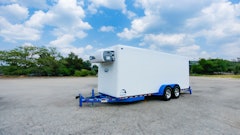VITAL STATS
Located between Montana and Minnesota.
Population: 642,200
Land Area: 70,704 square miles
Border Patrol: North Dakota is the fourth largest point of entry for Canadian goods by rail and truck.
Relaxed Taxes: A five--year property tax exemption can be granted to new and expanding businesses.
North Dakota is a hub of activity these days. The state is ripe with opportunities for food companies, and North Dakota just might be another of those overlooked regions with excellent potential to any company in the food arena. Offering numerous business and workforce incentives, North Dakota is building upon its reputation as a business--friendly state. In fact, about 40 percent of the state’s economy is involved in the food industry.
Among the variety of available business incentives, the state offers a 10--year property tax exemption, no sales and use tax on construction materials and equipment and a five--year income tax exemption.
"Our state works diligently to provide incentives to assist new and expanding businesses during the first five to 10 years of their operation in order to get companies to the level of profitability faster," says Linda Butts, director of the economic development and finance division of the North Dakota Department of Commerce.
As for workforce incentives, a federal program, Workforce 2000, and a state program, New Job Training Program, offer companies opportunities for low--cost or no--cost employee training.
The state is a natural location for food--related businesses, with its long agricultural heritage. "We are not that far removed in generations from when farming was North Dakota’s economy," says Cory Finneman, vice president of research. Today, the percentage of the state’s economy devoted to farming is about four times that of any state in the country.
"There is a superior appreciation of the food development chain here in North Dakota," says Butts.
Food processing is among the top five targeted industries for growth in the state. "So there is a lot of emphasis and support in this industry," Butts says.
Fargo (metro population of 175,000) is a major location for food companies, as it sits at the intersection of two major interstates: I--94 for east--west movement and north--south I--29. The city is quickly becoming a major distribution center for the upper Midwest. Finneman says: "That crosshair of north--south--east--west makes it a natural center for distribution--both by truck and by rail, with the Burlington Northern Santa Fe and Canadian Pacific (BNSF) running through the area."
Bismarck (metro population of 95,000) has a new 200--acre city--owned and industrial--zoned industrial park, Northern Plains Commerce Centre. The city also is in the process of building a trans--loading facility, which will offer intermodal opportunities. "This facility, ready for business by the fall, will change the dynamics of distribution in the upper Midwest region by connecting it to the global marketplace," says Butts.
The Commerce Centre will have operations involving rail, truck, air carriers and access to ocean--going cargo vessels. It will also have a Foreign Trade Zone designation.
Businesses will have a single location for their goods to be stored, loaded for shipment and off--loaded from inbound shipments, a centralized DC, and a place to clear customs.
Butts says BNSF is committed to designating Bismarck as a premier transload facility within its nationwide network and short--line Dakota, Missouri Valley and Western Railroad will interact with BNSF to facilitate easy transport. The indoor loading and off--loading facility will accommodate truck and rail operations and will provide climate--controlled storage.
Equidistant between these two cities and residing on I--94 is Jamestown, the state’s only food--processing industrial park on 200 acres. Grand Forks, about 70 miles north of Fargo on I--29, also offers excellent opportunities to food--related businesses. The BNSF’s main line serves this region, with numerous trains daily.
"The state has abundant excellent water and low--cost energy (electricity and natural gas), with eight power generation plants in the state," Butts says. "We export 70 percent of the electricity we produce."
Finneman notes the state is working hard to develop the entire food chain and to utilize natural synergies between companies. "This means where one food processor can build off another food processor so secondary and third--level food processing opportunities can take advantage of some of the byproducts of other companies," he says.
---------------------------------------
Red River Commodities Inc.
Snack Heaven
Red River Commodities Inc. chose to locate in Fargo, ND, to be close to its source of raw materials. "Right in our backyard stands one of the most unique and excellent growing regions for many of the specialty grains we need for our products," says Bob Majkrzak, president and CEO.
Sun Gold Foods, the finished food products division of Red River Commodities, produces a variety of soy bean and sunflower products as well as trail mixes. The company also produces pumpkin--kernel food snacks and specialty beans for human consumption and grains for bird seed production.
In fact, the company is an example of the North Dakota philosophy of using synergies between food production to create other products––and thereby other markets––from byproducts of the original human food products. "Our goal is to be as a tree--nut--free and peanut--free facility," says Majkrzak.
Another benefit to Red River’s location is its proximity to North Dakota State University, where the USDA agricultural research station for sunflowers is located. These food researchers helped Sun Gold develop its Sun Butter product and other specialty products. "They have been very helpful to us and they offer us a place to go to get answers," says Majkrzak.
Without help from state and university resources, Majkrzak says developing and launching new products such as Sun Butter would be a lot more difficult. "These incentives are a welcome shot in the arm for us."
Majkrzak says the Fargo location offers tremendous logistical benefits to the company. "We have easy access to Minneapolis, Seattle and Chicago via I--94; and I--29 gives us access from Winnipeg to Texas," he says.
Red River Commodities ships full containers of products such as sunflower kernel, flax, millet and specialty soybeans that are further processed by other companies as ingredients in producing baked goods.
"Germany, the Netherlands and Spain are the biggest overseas landing points receiving our products for baked goods," Majkrzak says. Containers travel by train (BNSF and then CSX) to Montreal, where they are loaded onto ships for the journey across the Atlantic.
The majority of its products shipped to U.S. receivers are sent by dry van. "Outbound capabilities from Fargo have been so good to the point that large companies we deal with––like Wal--Mart and Lowe’s––have found it very acceptable to pull large amounts of volume from this region," Majkrzak says.
On the inbound side, the company receives about 95 percent of its raw materials via hopper--bottom trucks.
North Dakota’s business incentives can be a great deciding factor for any business considering this location––or any other in the state, Majkrzak says.
"Fargo has put together a very aggressive economic development group that assists new business trying to enter the region. And the city doesn’t forget about the existing businesses already here and it continues taking care of existing businesses," he says.














